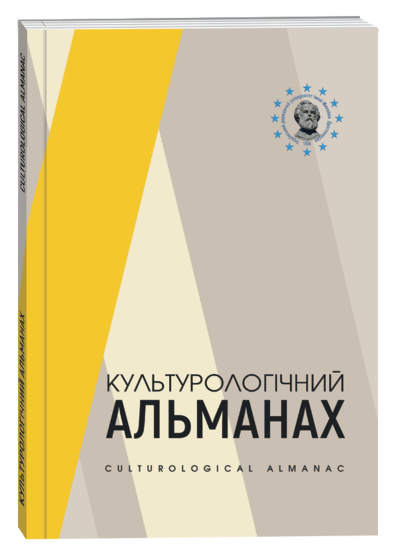THE PLACE OF SMART WATCH IN RHEALOGY: A CYBERCULTURAL ANALYSIS
DOI:
https://doi.org/10.31392/cult.alm.2022.3.31Keywords:
Smart watch, rhealogy, thing, functionality of a thing, thing as a symbol, cybercultural analysisAbstract
The work carried out a cybercultural analysis of Smart watch as a single thing that affects the life world of a person, the formation of his worldview. Rhealogy is presented as a new area of humanities, non-standard study of nonfunctional symbolic meaning in things. A methodological turn has been revealed in modern humanitarian knowledge to rhealogy as an analysis of the world of things in the daily practices of culture, which makes it possible to interpret the symbolism of a thing (for example, Smart watch) as a form of personal rooting in the being of culture.
References
Apple watch human interface guidelines. URL: https://developer.apple.com/watchos/humaninterface-guidelines/
overview/.
Barthes, Roland (1983). Système de la mode. Editions du Seuil, 330 p.
Barthes, Roland. (1977). Elements of Semiology. Farrar, Straus and Giroux, 111 p.
Barthes, Roland (1972). Mythologies. Farrar, Straus and Giroux (edition).
Epstein, Mikhail (2019). A Philosophy of the Possible: Modalities in Thought and Culture. Transl. by Vern W. McGee and Marina Eskina. Boston, Leiden et al: Brill Academic Publishers / Rodopi (Value Inquiry Book Series), 365 p.
Huang, J., Badam, A., Chandra, R., and Nightingale, E. B. (2015). Weardrive: Fast and energy-efficient storage for wearables. In USENIX ATC.
Kate Crawford, Jessa Lingel and Tero Karppi. (2015). Our metrics, ourselves: A hundred years of self-tracking from the weight scale to the wrist wearable device. European Journal of Cultural Studies, 18(4-5), P. 479–496.
Liu, R., and Lin, F. X. (2016). Understanding the Characteristics of Android Wear OS. In MobiSys, 2016.
Mark T Smith. (2007). Reconciling ICT and Wearable Design: Ten Lessons from Working with Swatch. The Role of Design in Wearable Computing, P. 16.
Melanie Swan (2012). Sensor Mania! The Internet of Things, Wearable Computing, Objective Metrics, and the Quantified Self 2.0. Journal of Sensor and Actuator Networks, 1(3), P. 217.
Miao, H., and Lin, F. X. (2016). Tell your graphics stack that the display is circular. In HotMobile.
Optimizing for Doze and App Standby. URL: https://developer.android.com/training/monitoring-device-state/doze-standby.html.
Reza Rawassizadeh, Blaine A Price and Marian Petre (2014). Wearables: has the age of smartwatches finally arrived? Communications of the ACM, 58(1), P. 45–47.
Rightspot: A novel sense of location for a smart personal object. in (Dey, A., Schmidt, A. and McCarthy, J. eds). UbiComp: Ubiquitous Computing, Springer Berlin Heidelberg, 2003. P. 36–43.
Santagati, G. E., and Melodia, T. (2015). U-Wear: Software-Defined Ultrasonic Networking for Wearable Devices. In MobiSys.
Sending and Syncing Data with Watch. URL: https://developer.android.com/training/wearables/data-layer/index.html.
Shen, S., Wang, H., and Choudhury, R. R. (2016). I am a smartwatch and i can track my user’s arm. In MobiSys.
Smartwatches now more popular than Swiss watches. URL: https://www.cnet.com/news/smartwatches-nowmorepopular-than-swiss-watches-thankslargely-to-apple/.
Specification of the Bluetooth System (Core Specification). URL: https://www.bluetooth.com/specifications/adopted-specifications, 2014.
Zhang, L., Tiwana, B., Qian, Z., Wang, Z., Dick, R., Mao, Z. M., and Yang, L. Accurate Online Power Estimation and Automatic Battery Behavior Based Power Model Generation for Smartphones. In CODES+ISSS, 2010.
Єрмоленко В. (2017). Барт, або Втрата. Володимир Єрмоленко. Далекі близькі. Есеї з філософії та літератури. Львів : Видавництво Старого Лева. С. 205–226.
Барт Ролан. (2022). Філософський енциклопедичний словник / В.І. Шинкарук (гол. редкол.) та ін. Київ : Інститут філософії імені Григорія Сковороди НАН України : Абрис. 742 с. С. 47.
Розова Т.В., Чорна Л.В. (2015). Людина. Культура. Філософія. (Проблема людини в європейській філософії) Книга 1. Київ-Одеса : Освіта України. 328 с.
Русаков С.С. (2020). Теоретична модель колообігу культури як культурологічний підхід у вивченні феноменів сучасної культури. Питання культурології. № 36. С. 24–37. URL: https://doi.org/10.31866/2410-1311.36.2020.221040.








